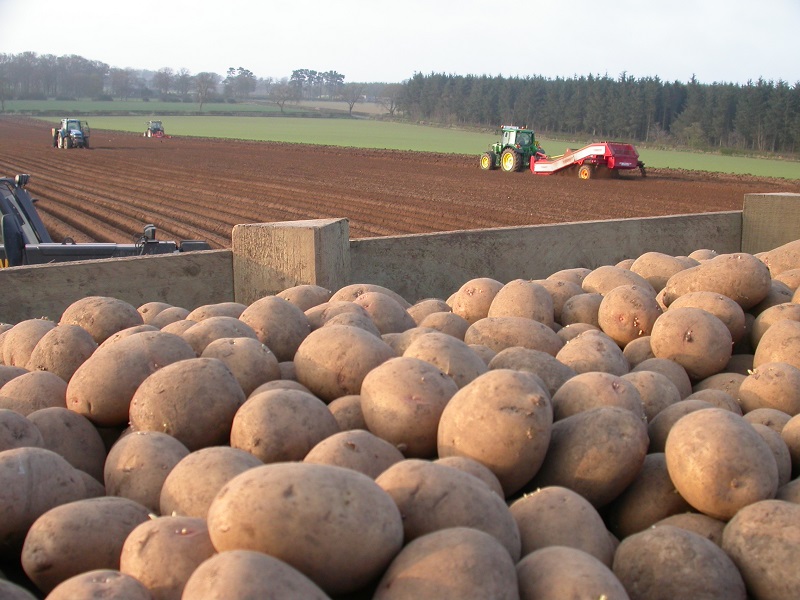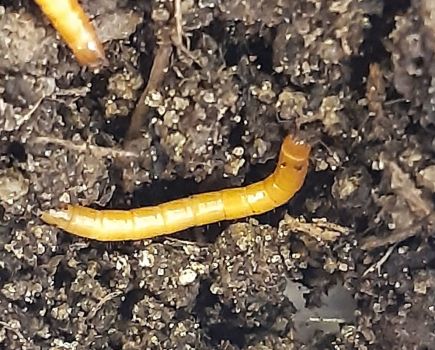The potato sector has suffered more than its fair share of pesticide losses over the past few seasons. Fortunately some new products have gained approval to take the place of some old stalwarts. CPM reports.
If Meloidogyne becomes established in potato soils, PCN and FLN will arguably become an irrelevance.
By Rob Jones
Concern surrounding the threat posed by soil-dwelling nematodes and the risk they pose to crop performance could see land managers under pressure to declare ‘pest-free status,’ warns Dr Roy Neilson of the James Hutton Institute speaking at the Bayer Potato Conference.
He notes the increasing recognition given to soils in delivering the ecosystem services enjoyed by society and how this may come to be reflected in future polices and the impact these may have on crop protection.
The problem confronting growers is that actions taken to counter the threat posed by one type of nematode, such as potato cyst nematodes, may not be effective against another, such as free-living nematodes.
“The strategies of the future will have to consider the full rotation and the interactions between species and crops. Beyond this, it seems likely that management policies may have to be developed at the catchment or larger scale,” he says.
“This is a different approach and it requires an agreement between all parties as to what the priorities are, be they financial, environmental and if so, which aspects, or a balance of both. The current system is easily skewed depending on the priority of the land manager.”
Noting that nematodes are the most abundant animal on earth, Roy explains that for every species that is pathogenic to crops, there are six or seven species that are beneficial.
“The two types work in concert, often to the overall benefit of the plant. It’s a complex dynamic and the challenge to growers is to balance efforts that seek to protect crops while supporting the organisms that ensure a functional soil,” he says.
Beyond conventional control methods, research has investigated the contribution to control represented by cover crops while more recent work is investigating the potential offered by live bacteria.
“Research has identified the potential of biocontrol options such as Pasteuria, a pathogenic bacterium, to influence populations. Surveys of non-agricultural soils across Scotland have sought to identify which strain of the bacterium is naturally present in the soil.
“The findings reveal there are several Pasteuria genotypes and that nematode populations are influenced by a range of factors including soil type, bulk density, carbon content and moisture. This means that any management intervention may well be field specific and that no one method will deliver the control desired.
“The potential of cover crops too has been investigated, but their influence on nematology is inconclusive. There are some successful experiments showing management of FLN and there is other work which shows cover crops increase populations. A recent two-year study investigating seven types of cover crop found no overall impact on nematode populations.”
Research both in the UK and internationally has implicated nematodes in the spread of disease, which further supports the need for effective management.
“US researchers found that feeding damage caused by root lesion nematodes (Pratylenchus spp) led to a greater incidence of potato early dying (PED) disease, which is primarily caused by the fungal pathogen Verticillium dahliae. We understand there are anecdotal instances of PED in the UK.
“In Norway, Pratylenchus has been implicated in the development of common scab. We have investigated this at JHI and found it in the lesions on tubers and while this is not evidence per se, it suggests there is a relationship (between Pratylenchus and common scab).”
After receiving several anecdotal reports indicating an increase in the incidence of black leg in the presence of large FLN populations, the JHI conducted some pot tests. “We’ve been able to confirm this relationship in laboratory tests, but it has not been validated in the field,” he notes.
In a word of caution, Roy encourages growers to be vigilant to the threat posed by root-knot nematodes, specifically Meloidogyne species, which are neither a FLN or a PCN. Meloidogyne minor has recently been confirmed in the Netherlands as a pathogen of potato.
“M. minor is one of four species of root-knot nematode that poses a danger to UK agriculture. It’s widespread across continental Europe and there are unverified accounts of it in the UK. It behaves much like PCN in that it inhabits the root of the crop.
“The damage it causes to potatoes is potentially catastrophic and if Meloidogyne becomes established in potato soils, PCN and FLN will arguably become an irrelevance. Be aware, nearly all rotations followed in the UK would support root-knot nematode species,” he comments.
The threat posed by nematodes was not lost on Edward Hagues, Bayer root crop product manager, who notes Velum Prime (fluopyram) received positive first-year reports from users.
“The user feedback has been overwhelmingly positive. Comments such as ‘effective performance against PCN’, ‘more advanced crop canopies’, and ‘easier to handle and less packaging to dispose of’ are encouraging. Having tried it successfully, two-thirds of those surveyed plan to use it over a bigger area in 2020,” he says.
From its launch in the winter of 2018, Bayer has positioned Velum Prime as an effective nematicide capable of delivering yield protection and population management when applied on its own or in combination with a granular nematicide. It has stressed that many elements will influence the nematicide programme choice, and a full range of factors, including PCN pressure and soil type, should be considered.
“On average an application of Velum Prime in sequence with a full-rate granule resulted in slightly better yield protection than applying a full-rate nematicide on its own. But where conditions favoured nematicide performance, we saw instances where a significantly greater yield response than the average was delivered.”
Results from 2019 trials further support its use in lower pressure situations where growers may have previously opted not to use a nematicide. “In trials spanning seven seasons, the average yield response from the use of Velum Prime in sites with less than 5 eggs/g soil was 2.1t/ha and a reduction in PCN multiplication of 41% compared with the untreated,” explains Edward.
Under higher pressure situations, the use of Velum Prime in combination with either Vydate 10G (oxamyl) or Nemathorin 10G (fosthiazate) continued to result in yields better than achieved by either granular product when applied alone.
“The results for Velum Prime applied in a programme with either half-rate Vydate or Nemathorin were comparable, often slightly better than full rate granules. This is reflected in user experience too,” he adds.
Trials performed in 2018 and 2019 found that when Velum Prime was applied with full-rate Vydate 10G, yields were on average 1.3t/ha higher than Vydate-only treated crops. When it was applied with full-rate Nemathorin, yields were 3.75t/ha higher than Nemathorin-only treated crops. Both programmes also gave an improvement in PCN population management.
Bayer hopes to receive approval for overall application by use of a conventional boom sprayer in time for the coming season, though an application to have free-living nematodes added to the label was unlikely before 2022 as further data is needed.
Further additions to the armoury
A novel means of improving protection against seed-borne Rhizoctonia solani may be on the way after Bayer applied for on-label approval for Serenade ASO. The product, which contains Bacillus amyloliquefaciens QST 713, is already available to growers for protection against seed-borne R. solani under an Extension for Authorisation for Minor Use (EAMU).
“Although yet to receive CRD approval, we believe the data generated so far supports its use at the rate of 5l/ha applied in-furrow for useful protection against tuber diseases,” says Edward.
If regulatory approval is received Bayer will communicate it to the industry, though it warned that the timeframe is uncertain and consequently it may not be in time for the 2020 season.
Identifying which herbicide or combination of products might be relied on to deliver the best all-round control of weeds is still a work-in-progress for many potato growers, but trials performed over the past few seasons show a clear path forward, believes Jack Hill, Bayer roots and horticulture commercial manager.
“Emerger (aclonifen) continues to prove a versatile and reliable residual herbicide with a broad-spectrum of activity, good tank-mix compatibility and no varietal restrictions,” he says.
Application practice is, however, central to its performance. “It needs to be applied to a uniformly even, friable seedbed to form a consistent film and the soil should not be disturbed after planting. Incorporation or disturbance by hoeing will reduce its activity as there is little herbicide uptake by roots,” he said.
Bayer has assessed Emerger’s performance in combination with a range of tank-mix partners, including those containing either metribuzin or prosulfocarb.
“Mixed with Artist (flufenacet+ metribuzin), growers have a very robust two-product programme. When Emerger is mixed with Sencorex (metribuzin) it’s still a good programme, while at the same time being lower cost. Nor are there any concerns when mixed with Defy (prosulfocarb), but we appreciate this combination will be dependent on the weed spectrum concerned,” says Jack.
Mixes with Stomp (pendimethalin) plus Defy gives strong weed control where metribuzin is not recommended, while Emerger with Defy and Sencorex proved useful where a very low rate of metribuzin is acceptable.
“Emerger is a consistent performer against a wide range of weeds and will become a key herbicide for the potato crop,” he concludes.
Finding the right fit
The European Commission’s decision to reduce the maximum residue limit for Monceren (pencycuron) to a practically unworkable level means growers are having to investigate the alternatives.
For north Norfolk farm manager, Adrian Howell of Turnstone Farms, a 2400ha joint-venture with land between Swaffham and Holbeach, finding a suitable alternative rhizoctonia treatment involves two key considerations – product efficacy and application performance.
“All of our crop is for the pre-pack market. Quality of skin finish is of paramount importance, so we take cultural controls such as rotation and good field hygiene seriously. But while we follow a long rotation of either one-in-seven or one-in-eight, the silt soils have a long history of potatoes so there is a strong imperative to protect crops,” he explains.
“Monceren has been a reliable and effective product for so many years, but the need to identify an alternative has provided the opportunity to review how we approach the whole process,” he adds.
“I’m not a fan of liquid treatments because of the time and impracticalities involved in the application process. This left two powder treatments, both of which required investing in an on-planter powder applicator, so it came down to which had the better flow properties,” he explains.
In the end, Adrian opted for Emesto Prime over flutolanil-containing products. “Other users say it flows as well as Monceren did, while its performance in trials and among users suggests its efficacy is even better than Monceren. It was the logical choice.”
With pre-pack potatoes across roughly 60ha of sands and 30ha of silts, Adrian Howell’s herbicide choices have to reflect a diverse weed spectrum and the risk of crop damage.
“Since the loss of linuron we’ve largely relied on either metobromuron and metribuzin across the silts or a combination of pendimethalin plus prosulfocarb on the sands. Last year I was able to access a small amount of Emerger which I used on the silts in combination with metribuzin and prosulfocarb.
“On the sand, where fumitory has always escaped pendimethalin and can be a problem weed for us, I’m keen to see how Emerger performs,” he says.
This season he plans to make greater use of Emerger and undertake a split field trial with metobromuron to give a direct product comparison.
“I’m particularly keen to increase its use on the sandy soils as I think its persistent residual performance will enable me to reduce the number of herbicide applications needed from two to one, without compromising crop safety,” he says.




